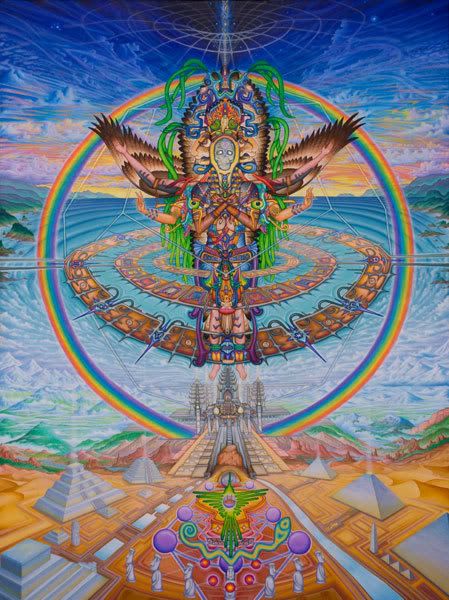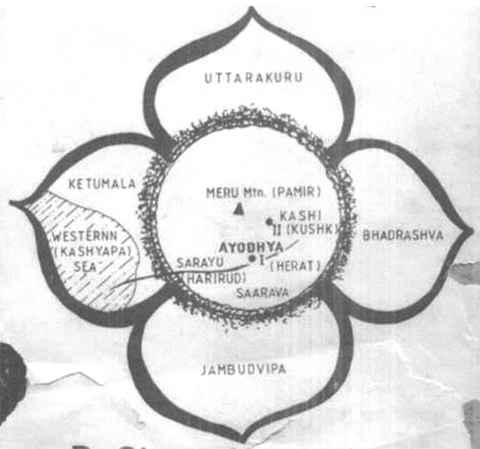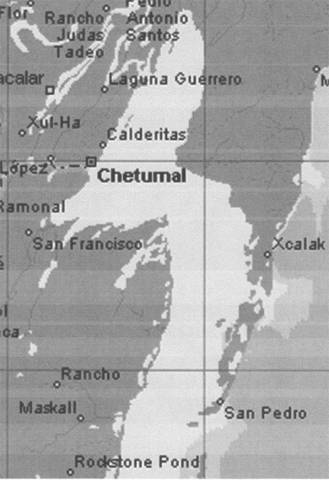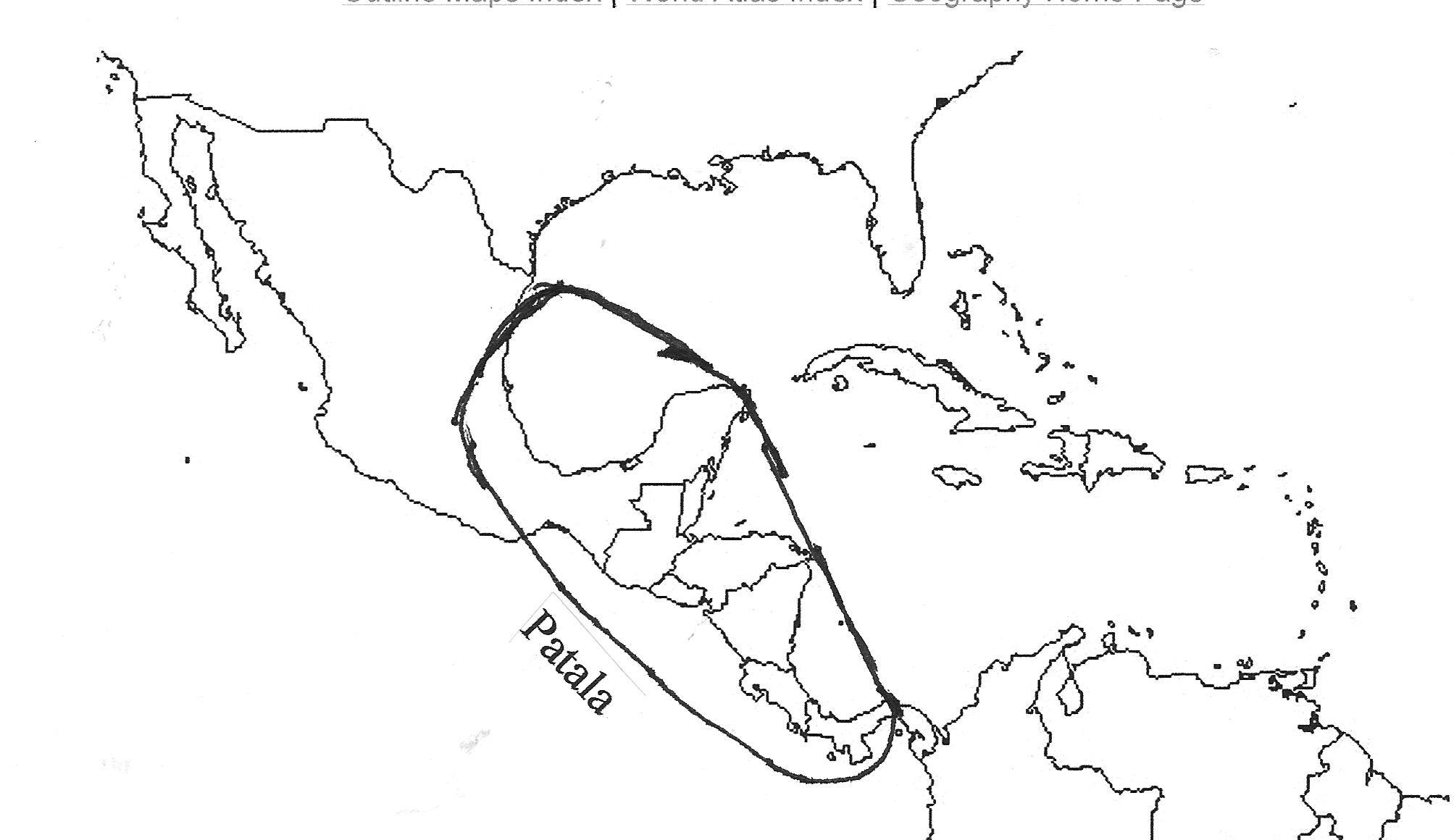India's Conquest of the Americas


by Gene D. Matlock
In the
late 1970s, when I discovered that ancient India not only once owned the world, but gave us all our
religions as well, I felt like a second Columbus . Moreover, I naively thought
the world would applaud my work. I soon discovered that all the truths in the
world won't alter the mindset of people steeped in sectarian religious beliefs,
and that their historical conditionings, though changeable, don't become
unfrozen easily, either.
Those who have read my previous articles will realize I have repeated information they already know. But there is one set of facts they don't know yet. These are the ones that will cause the rewriting of Hindu history.
The Vedas tell a number of valid facts about ancient America . They call Mexico and Central America Patala. In Sanskrit, Patala means 'one of the seven regions under the earth and the abode of serpents' According to the myths, an eagle named Garuda transported thousands of ancient mariners, called snakes (Nagas, there in its beak. Although I feel they came here in ocean-going ships, the implication is clear that they could have flown here as well. The legends of the O'odhams of Arizona describe such a sky-born ship. They call it Nah-Big, a term definitely derived from the Sanskrit Nag-Bhaga or Snake God. One cannot help but become impressed when he reads the O'odham stories of the Nah-Big. It is clear that it was some kind of flying ship. The O'odhams even speak of it as being propelled by an energy generator having positive (male) and (female) female poles.
Did a Patala ever exist in ancient Mexico? It certainly did and does. In the Mayan-derived dialects along Mexico's northern east coast down to and including the Central America republics, Patal means 'abandoned or deserted land; without people.'
Naga-like derivatives also exist in Mexico . In Sanskrit, Nag-asta means Western Naga Land . The Mayan lowlands down to and including Costa Rica are called Nacaste.
According to Hindu legends, a naga could turn into a human being. In Mexico, a nagual was a were-animal. Nagual derived from the Sanskrit Nag-Baal, meaning Snake Demon.
In his book, Remedy the Frauds in Hinduism, Indian historian Purushothoma Chon mentioned a Siberian origin of the Mayans: 'Maya architects are mentioned in our epic Mahabharata. Maya people are in Siam and East Asia . There is a place called Mayyava in Kerala. The Utttar Pradesh people have the meaning of Mayya as mother in phrases like 'Gang ki Maya.' There is a vast area in Russian East Siberia as well as a river by name Maya.' (p. 28.) The Nagas of Tibet even had a similar bar and dot counting system, along with the same words, to the Naga Mayas of Mexico.
The Hindu Naga Mayas also belonged to a powerful Dravidian group of Nagas called Asuras. Whether or not the Asuras were demi-gods or demons depended on one's point of view. The leader of these Naga Asuras was the Hindu (really a Bulgarian) god of precious metals, wealth, traders and even agriculturists (really a group) named Kubera or Khyber (Kheever). For Christians and Jews he was Heber. This Kubera, Khyber, or Heber was leader of a horde called Yakshas or Yakhas (Biblical Joktan?). They were reputed to be both superior mentally and materially. Their servants were called Guhyakhas (Yakha shit). Today, in Judaism, which evolved from the Kubera teachings, the term has changed to Goy, but the meaning has never changed. The Kubera hordes, composed of Yakshas or Yakhas and their Guyakha underclass captured most of India's undesirables, the unredeemably savage and cannibilistic Rakshasas, exiling them to Ceylon or Lanka. Later, they exiled them to Patala, supposedly in air ships.
The Mayas
had their own nation in Lanka, also named Maya, with a sub-group called Laks
(Mexico's Lacandones). It is a strange anomaly that Rama, Lenka (Lanka), and
Lacandon Mayan peoples exist in Meso-America, including the inhabitants of
Yucatan (Yakhustan; Joktan?). As further evidence that Kubera or Khyber first
settled the Americas , the Meso-Americans told the Spaniards that a strange
people had once gone there, naming all of the North American continent Quivira
(Kheeveria). The most sacred mountain of the Arizona O'odhams was the
gold-filled, rattlesnake infested Baboquivari. There were also Quiburi people
and a Quiburi creek in O'ofham country. Kubera--like names also exist among the
Caddo Indians of Texas and Louisiana, as well as the North Mexican mining state
of Coahuila (true pronunciation Kovira), the Sonoran mining town of Caborca ,
and the Texas and Northern Mexican Cahuillas (Kaviras). There are also the New
Mexican Indian ruins of Gran Quivira and Koari. It is from this international
word Kubera that we have derived the words quarry and copper. Yes, you'll find
Kubera's name pronounced in one form or another all over the world.
It just so happens that the Carib (Cariva) Indians of the Caribbean islands claimed that their creator gods were the Kuru Rumani. The Mexicans will tell you that the state of Veracruz derives its name from Ver a Cruz (Seeing at a Cross), but such a name is preposterous for a variety of reasons. The people of Vera Cruz are really descendants of Carib Indians, called Vira--Kurus (Hero Kurus). Emperor Moctezuma of Mexico himself told the Spaniards that the Mexican royal family descended from a ruling eastern caste called Colhua, the only way the Aztecs could pronounce Kaurava.
I could provide almost an infinity of evidence to validate my claim that the Kurus and Ramas (Aryans and sub-continent Hindus) first colonized the Americas , but that's not necessary. What I have to say in the last part of this article is sufficient unto itself.
The Hindus of antiquity had an ancient astro-geographical map with four lotus petals pointing in the cardinal directions, called Mt. Meru (the world mountain). The point of the left petal fell on a seaport called Ketumala or Chetumala. Both pronunciations were used. The lower center petal was Jambudvipa (subcontinent India ).
One day, I decided to examine a map of Meso-America in order to find out whether a Chetumala or Ketumala ever existed there. It did not take me long to find out that Chetumal is even now a safe port in what is presently Belize, Central America. (See the illustrations below). The name of this port of Chetumal has never changed in all these thousands of years. According to the available evidence, I knew I had found the Chetumala depicted on the point of the left petal of the Mt. Meru drawing. But the skeptics and so-called 'historians and mytholigists' who are dead set against India knowing the truth about herself, for foolish reasons only they can know, insisted that the Central American Chetumal was just a coincidence. What I have never revealed to anyone until now is that the Belize Chetumal is absolutely nothing compared to the total proof you will learn in my upcoming conclusion to this article. However, my life is steadily going to its inevitable end. In order to produce fascinating articles, I have spent too much time writing anti-climaxes, while simultaneously honing my own historical skills to near perfection, building up to the time when the hero finally gets the girl. I must act now while there is still time.





You will notice that just to the left of the Chetumal petal there is a body of water called the Kashyapa Sea . A meaning of Kashyapa is 'sea turtle; tortoise.' We now call the Kashyapa Sea the Caribbean Sea . It is commonly known that more sea turtles of different species inhabit Meso--America and Eastern Central America than any other place in the world. One species in the region, the Hawksbill, has always been hunted for its beautiful shell which, for thousands of years, has been used to make fine ornaments. In ancient days, there were uncountable millions of Hawksbills in the Caribbean Sea . Because of centuries of feverish and constant harvesting, the Hawksville population has shrunk to an estimated 22,000 nesting females. Belize itself is a composite Sanskrit word Bala= Facing the East; The Rising Sun. Isha or Isa = God Shiva. Belize indeed faces the east.
But not even this is enough proof for those wanting to keep India hidden under the rug. So now it's time to reveal something that no rug can ever hide. Chetumala or Ketumala is not the official name of the left petal. It is the official name of the harbor itself. The full territory was called Aparagoyana or just Goyana ( Guyana )! Apara=Western; being in the west of; a bad shore. Guh=concealed; hide; keep secret; a hiding place; filth; etc. Yana=journey; going; moving; riding; a vehicle of any kind; ship, etc. (See ancient Geography of Ayodhya, by Dr. Shyam Narain Pande; p. 8, plus 87 other references listed in the Internet.)
Aparagoyana ( Guyana ) clearly tells us that the Guhyakas and the Rakshasas were being exiled to Guyana because the civilized world was ashamed of them. Today, the name Guyana has shrunk to just the top right half of South America, but a sizable portion of the territory still retains enough of the ancient name of the left petal to let us know that the total region was in no way named Ketu Mal but Apara-Guyana. On the map itself, you will see Guyana as the first nation. The second nation's name has been changed to Suriname, which is also derived from Sanskrit. Suri is a name of God Krishna. Nama=Named. The third one at the right is French Guiana or French Guyana.
It is a
fascinating anomaly about these nations that the majority population is of East
Indian descent. People of African descent come next. After that, mixed races,
European (mostly Portuguese) and Chinese.
So now, my Hindu friends, you have this part of your history back. And the orthodox historian villains are growling, 'Curses, foiled again.!' It's not so preposterous as Kubera 'spending ten thousand years with his head below water,' either. It is one hundred percent fact. No skeptic or religio-cultural enemy of India can ever twist this truth to mean something it is not. The truth of India's dominance and colonization of the ancient Americas is nakedly exposed to the whole world. If you don't take the initiative and start rewriting your history books right now, you have no one but yourselves to blame when the self-worshiping 'rational' academics try to cannibalize you!
I want to add that I also accidentally stumbled upon the method of unlocking the simple to learn secret of decoding the so-called mysteries of Hindu mythology. They aren't mysteries at all but probably the most scientific books ever written. Once a person learns this trade secret, he can make valid conclusions whereas others, especially 'smart rational, can't be fooled western scientists and orthodox historians' cannot -- and won't. The critics of the Hindu holy books would really feel like -- or actually become -- fools if they knew what they were mocking. They're really quite easy to unravel -- much like finding the way out of simple mazes. Since I have concentrated mostly on the mystery of whether or not India and the Turks, a.k.a. The Holy Twins, discovered the Americas, I may have worked myself out of a job. I must find other Hindu oriented mysteries to unravel.
My detractors often say to me, 'Well, if that trade secret is so easy to learn, why don't you give it to the world?'
This is my answer: Mankind is worse ethically and morally than the most brutish of apes. He appears determined to kill not only himself, but everything else on this planet. So why did Thomas A. Edison destroy many of his most potentially lethal mathematical discoveries before he died? Or why did the widow of history's most famous sexologist, Sir Richard Burton, burn his papers after his death? Or let me put it this way: Are you pleased to know that Iran has learned how to manufacture nuclear weapons?
From Viewzone @ http://www.viewzone.com/gene.india.html
For more hidden history see http://nexusilluminati.blogspot.com/search/label/hidden%20history and http://nexusilluminati.blogspot.com/search/label/forbidden%20archaeology
- See ‘Older Posts’ at the end of each section
YOU can help this unique
independent website’s author survive in a small cabin in a remote rainforest
Donate any amount and receive at least one New Illuminati eBook!
Please press the
button -
Xtra Image – http://i84.photobucket.com/albums/k21/bluartist/eb804a47-93ee-48dd-b001-621d6e46cb4.jpg
For further enlightening
information enter a word or phrase into the random synchronistic search box @ http://nexusilluminati.blogspot.com
And see
New Illuminati – http://nexusilluminati.blogspot.com
New Illuminati on Facebook - https://www.facebook.com/the.new.illuminati
New Illuminati Youtube Channel - http://www.youtube.com/user/newilluminati/feed
The Her(m)etic Hermit - http://hermetic.blog.com
The Prince of Centraxis - http://centraxis.blogspot.com (Be Aware! This link leads to implicate &
xplicit concepts & images!)
DISGRUNTLED SITE ADMINS PLEASE NOTE –
We provide a live link to your original material on your site - which
raises your ranking on search engines and helps spread your info further! This site
is published under Creative Commons Fair Use Copyright (unless an individual article
or other item is declared otherwise by copyright holder) – reproduction for non-profit
use is permitted & encouraged, if you give attribution to the work &
author - and please include a (preferably active) link to the original (along
with this or a similar notice).
Feel free
to make non-commercial hard (printed) or software copies or mirror sites - you
never know how long something will stay glued to the web – but remember
attribution! If you like what you see, please send a donation (no amount is too
small or too large) or leave a comment – and thanks for reading this far…
Live long
and prosper!
From the New
Illuminati – http://nexusilluminati.blogspot.com






